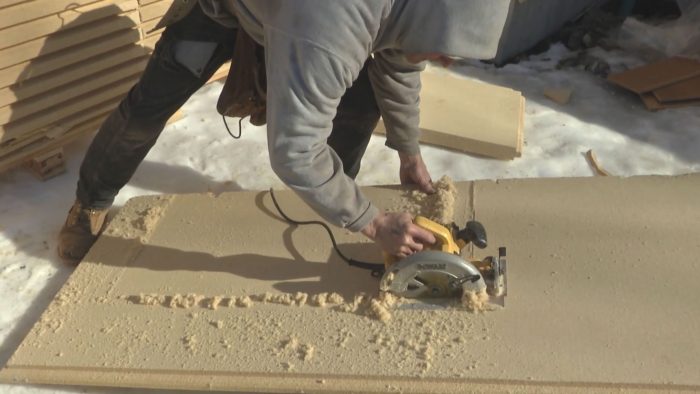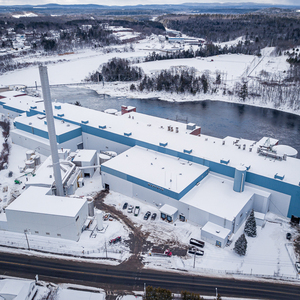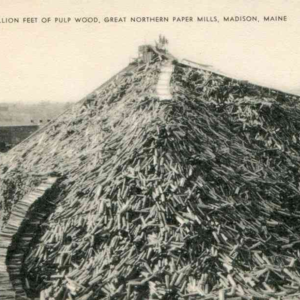With our wall assembly here, we have the 2×8 framing, which is going to get dense-packed full of cellulose. And then we have exterior rigid wood-fiber insulation from Steico that goes onto the building. We really like this stuff because it’s carbon-storing and because it’s very permeable, which allows moisture to pass freely through the assembly.
Specific heat capacity
It also has another benefit that we’re really just starting to understand, which is called specific heat capacity. Some materials have an inherent need for energy in order to raise their temperature. In other words, it takes more energy to raise the temperature of this wood-fiber insulation than it does of say a mineral-wool exterior insulation or a foam insulation. What that translates into is that when we have the ups and downs of temperatures, is it starts to even those out so we get smaller peaks and valleys in the temperature swings across our assembly. What this means is that we have a more stable building environment, which allows our mechanical systems to perform better and allows our clients to be more comfortable. Not only do we have the R-value to consider, but we also have to pay attention to the permeability and the specific heat capacity of our materials if we’re really trying to fine-tune our assemblies.

Material specs
This material is a European product that is 2-3/8 in., or 60 mm, and comes in 29-in. by 8-ft. sheets that tongue-and-groove together. One of the beauties of this stuff is that as it goes together, the seams don’t have to fall on framing. As long as each joint has a complete tongue and groove and they click together, you’re good—you can break in the middle of a cavity with no issues.
Installation
Putting this on the wall, we tape from our rim down to our foundation. We have a gasket in there, but this is a belt and suspenders acting as our air-seal and also as a flashing in the event that water should ever make it back there. Next, we have this piece of edge metal here that we bent up. This is acting as a ledger to rest the insulation on, but it’s also a two-part closure at the bottom of the wall. We put this on level around the building. We shoot it with a transit, find our points, snap the lines, and start attaching the metal. This gives us a starting point that all of our insulation rests on.
The insulation goes on with screws and these little washer setups here. These are little thermally broken washers. We only need to put a couple of these on per sheet because it’s really just tacking it onto the wall right now, because the next phase for us is going to be to add 1×3 strapping across here, which gets screwed through into the framing. This is what really clamps the assembly together and what will carry all of our cladding on the outside of the building. It also acts as the rainscreen for the building. Any moisture that passes through can freely ventilate through that cavity up and out, and then any water that ever makes it through the cladding can fully drain out to the bottom.
This edge metal at the bottom serves a couple of purposes. Number one, it will be perforated, which allows air to move through and water to drain out. It also act as a physical stop to prevent any pest from making its way into the rainscreen cavity and making itself a new home.
Ben Bogie is a second-generation high-performance-building obsessive working as a project manager for BPC Green Builders of Ridgefield, Conn. Photos courtesy of author.
RELATED LINKS
- Wood-Fiber Insulation Launch Planned for 2022—The First of its Kind in North America
- In Favor of Wood-Fiber Insulation
Weekly Newsletter
Get building science and energy efficiency advice, plus special offers, in your inbox.















22 Comments
Sure - another unobtanium. But nice to know.
In what way?
Unless you have it shipped from Europe - I haven't found any US based supply - maybe Mr. Maines has a source I haven't found. . As Bas mentioned - next year - perhaps. Does little for me now. I'm planning on finishing up my build by then.
“[Deleted]”
A lot of us are here to learn about the "best and latest". We're involved in this industry for the long term, because we're designers and builders. So, something that's coming down the road 3 years from now interests us.
It's too bad it won't be available for your particular project. But this is still valuable, useful information to many of us.
Wait a year Till These Boards are made in the US...
Made in the US by which enterprise next year? I know Gutex has been making noise about establishing a facility in Maine for years... but I'm sure the financial side continues unnaturally to favor petrol products due to unfathomable manipulation by money changers.
TimberHP, aka GO Lab. It's pretty far along in the process at this point, though the first product slated for release is loose-fill, batts and board to come later.
https://golab.us/
Wood fiber insulation is pretty easy to get, just a bit on the expensive side currently, compared to other rigid insulation. It has significant benefits over those products.
Bruh. https://foursevenfive.com/ I've had Gutex outbound on my house since 2018. Do it.
How do you perforate that edge metal after it's in place?
I'm curious as to why it and the insulation extends down about 6 inches over the concrete below. Maybe as backing for the cladding?
HI Trevor, that is just the support and not part of the rainscreen- no gap later in that position..
> benefits of wood-fiber insulation, plus .. installation process
It's accurately labeled. But I much prefer balanced reporting, with cons whenever benefit claims are made. Even better with some discussion of ROI (energy and carbon).
> specific heat capacity
"...thermal mass benefit is minimal in a cold climate...In the range of 1.5% annually."
https://cshub.mit.edu/sites/default/files/documents/ThermalMassBenefit_v10_13_0920.pdf
> mechanical systems to perform better and allows our clients to be more comfortable
Data?
> Carbon storing
The spreadsheet here shows fiberboard having slightly worse GWP than EPS:
https://www.buildinggreen.com/blog/global-warming-potential-insulation-materials-new-calculator
Its one of the "it depends" - for a dry climate with daily temp. swings it makes sense to delay the heat into the house till when you can ventilate it away. For a humid climate i am with you..
> It's accurately labeled. But I much prefer balanced reporting, with cons whenever benefit claims are made. Even better with some discussion of ROI (energy and carbon).
You won't get balanced reporting from the cellulose, Roxul, or petrofoam people—why hold nontoxic product makers and users to a higher standard.
> "When considered annually, thermal mass benefit is minimal in a cold climate."
https://cshub.mit.edu/sites/default/files/documents/ThermalMassBenefit_v10_13_0920.pdf
So material, though possibly not massive, benefit in cold climates—who wouldn't take better performance across the board, particularly with the boon of nontoxic material benefits.
> Data?
Indeed. When the toxic makers provide apples to apples comparisons, it gets interesting. Many of us understand the nonsense of "R-value", e.g. I AIN'T GETTING PAID HERE TO POST; I'M JUST A MESSENGER: PAY ME TO PRODUCE THE DATA AND I WILL. You're free to produce more data proving the outright superiority of alternative products such as fake polystyrene (styrene is extracted from storax balsam, which comes from a tree in Asia Minor called the Oriental sweet gum; sadly, shifts in integrity have led to the falsehood of liquid hydrocarbon, from which EPF is made, masquerading as styrene in the states) etc... though it's of course such data don't account for lifecycle "externalities". The petrol product makers will never produce apples to apples because they lose almost every time except for unrealistically controlled conditions beneficial to their stuff; sadly, they've cornered the market due to monetary and related policy here in the states since 1913... which is why the nontoxic stuff still comes from Europe.
How fire resistant is this product? For those living in wildfire country, how well can it hold up to a flame?
Also, how about termites? Lot of termites in the desert SW.
Passes stringent standards. Passes code in NYS... so I'd think it's good elsewhere. It's not 100% wood fiber—about 5% is a material infused into it that acts as a fire retardant. I toss it in my bonfires (I still have some of it left over from the build), and it's useless. Bummer?
Here's one vote to get the video autoplay turned off...
Would love a wall section of the house in this video! Looks like wood floor over a basement, which may be confusing my eyes on what's going where.
How are the furring strips being fasted? You mention those furring strips really clamping the assembly together so I should probably assume that you are screwing through the furring strips, through the fiberboard and into the framing. That about right? Would you do anything different if that exterior insulation was bumped up to 5.5 inches?
Is the "sheathing" layer on the inside of the stud wall? I'd also like to see a section of this assembly.
Log in or create an account to post a comment.
Sign up Log in